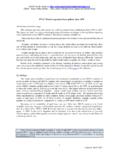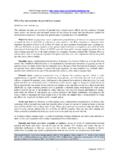Transcription of Parental Leave Policies in 21 Countries
1 Parental Leave Policies in 21 Countries Assessing Generosity and Gender Equality Rebecca Ray, Janet C. Gornick, and John Schmitt September 2008 Revised June 2009 Center for Economic and Policy Research 1611 Connecticut Avenue, NW, Suite 400 Washington, 20009 202-293-5380 Parental Leave Policies in 21 Countries : Assessing Generosity and Gender Equality i Contents Executive Parental Leave : Time and The Case of the United Parental Leave : Gender Gender Equality Index ..2 Best Practices.
2 2 Best Practices and the Case of the United States ..2 Parental Leave Policies in 21 Rich Countries ..5 Parental Leave for Public Policies and Employer Practices in the United States ..7 Gender Mothers in a Fathers in a Couple ..11 Leave Generosity for Couples, Mothers, and Gender Equality Index ..14 Financing Scheduling Best About the Authors Rebecca Ray is a research assistant at the Center for Economic and Policy Research (CEPR); Janet C. Gornick is professor of political science and sociology at the Graduate Center, the City University of New York; and John Schmitt is a senior economist at CEPR.
3 Acknowledgements We thank Heather Boushey and Dean Baker for many helpful comments and Nichole Szembrot for research assistance. Parental Leave Policies in 21 Countries : Assessing Generosity and Gender Equality 1 Executive Summary This report reviews the national Policies of 21 high-income economies, as of June 2008. We focus on two key aspects of Parental Leave Policies : the level of support provided to parents; and the degree to which Leave Policies promote an egalitarian distribution between mothers and fathers of the time devoted to child care.
4 Parental Leave : Time and Money Parental Leave laws can support new parents in two complementary ways: by offering job-protected Leave and by offering financial support during that Leave . In terms of time, all 21 Countries analyzed here protect at least one parent's job for a period of weeks, months, or years around the birth of a child. This job protection allows parents to take time to care for their infant or young child secure in the knowledge that they will be able to return to the same (or a comparable) job at the end of the Leave period.
5 Total protected job Leave available to couples varies widely across the 21 Countries , from only 14 weeks in Switzerland to over 300 weeks (about six years) in France and Spain. The United States, with 24 weeks of combined protected job Leave for a two-parent family, ranks 20th (out of 21); Switzerland provides fewer weeks of protected job Leave (14), but provides financial support of 80 percent of a mother's usual earnings during that Leave . In terms of money, almost all of the 21 Countries also provide direct financial support for parents during at least part of the protected Leave .
6 Most Countries provide between three months and one year of full-time-equivalent paid Leave ; Sweden, the most generous of the Countries examined, provides 40 weeks of full-time-equivalent paid Leave . The United States is one of only two Countries to offer no paid Parental Leave . Australia also offers no paid Leave , but supports new parents with a substantial financial baby bonus regardless of whether they take Parental Leave . The Case of the United States The Family and Medical Leave Act (FMLA) sets a minimum standard for Parental Leave , but due to the exclusion of small employers and short-tenure workers, about 40 percent of workers are not eligible for the FMLA.
7 In general, employers as a group have not stepped in to fill the gap. While about 60 percent of workers are eligible for FMLA-related Leave , only about one-fourth of employers offer fully paid "maternity-related Leave " of any duration, and one-fifth of employers offer no maternity-related Leave of any kind, paid or unpaid. Private employers do not appear to be narrowing the statutory gap in Parental Leave entitlements between the United States and the rest of the high-income Countries analyzed here. Parental Leave : Gender Equality In the absence of paid Parental Leave Policies , traditional gender roles that involve women as caregivers and men as providers , and the typically lower earnings of mothers (relative to fathers) in the labor market, create strong incentives for women to reduce their employment and take on a large majority of child care responsibilities.
8 The most obvious problems associated with such outcomes are that women bear a disproportionate burden of child care responsibilities and pay both Parental Leave Policies in 21 Countries : Assessing Generosity and Gender Equality 2 a short- and a long-term penalty in the labor market. A related issue is that traditional gender roles and labor-market outcomes work together to deprive men of the opportunity to participate actively in providing infant and child care. Gender Equality Index Parental Leave Policies can have an important impact on gender equality, both in the workplace and with respect to sharing child care responsibilities.
9 Hence, we sought a single measure that allows us to examine the effect of Parental Leave Policies on both the workplace and caregiving. To create such a measure, we constructed a Gender Equality Index, which measures Countries Parental Leave Policies on a fifteen-point scale, with fifteen points indicating full equality of workplace and caregiving benefits to men and women. Among our 21 Countries , Sweden earned the highest score (13 points). Finland, Greece, and Norway each earn 12 points, and Belgium and Portugal follow closely with 11 points.
10 France and Spain each receive 10 points. While the United States rates poorly on the time and money aspects of Parental Leave , on gender equality, the fares much better. The , along with Germany and Italy, falls right at the middle of the 21 Countries , with nine points each. Denmark, the Netherlands, New Zealand, and the United Kingdom trail slightly behind at eight points. Austria, Ireland, and Canada each earn seven points. Three Countries scored fewer than seven points: Japan (5), Australia (1), and Switzerland (0).





